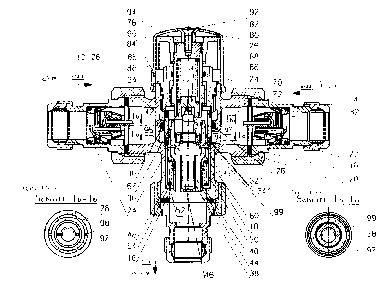Some of the information on this Web page has been provided by external sources. The Government of Canada is not responsible for the accuracy, reliability or currency of the information supplied by external sources. Users wishing to rely upon this information should consult directly with the source of the information. Content provided by external sources is not subject to official languages, privacy and accessibility requirements.
Any discrepancies in the text and image of the Claims and Abstract are due to differing posting times. Text of the Claims and Abstract are posted:
| (12) Patent: | (11) CA 2283973 |
|---|---|
| (54) English Title: | THERMOSTATIC WATER MIXER |
| (54) French Title: | MELANGEUR HYDRAULIQUE THERMOSTATIQUE |
| Status: | Term Expired - Post Grant Beyond Limit |
| (51) International Patent Classification (IPC): |
|
|---|---|
| (72) Inventors : |
|
| (73) Owners : |
|
| (71) Applicants : |
|
| (74) Agent: | SMART & BIGGAR LP |
| (74) Associate agent: | |
| (45) Issued: | 2001-07-10 |
| (86) PCT Filing Date: | 1998-03-19 |
| (87) Open to Public Inspection: | 1998-10-01 |
| Examination requested: | 1999-11-26 |
| Availability of licence: | N/A |
| Dedicated to the Public: | N/A |
| (25) Language of filing: | English |
| Patent Cooperation Treaty (PCT): | Yes |
|---|---|
| (86) PCT Filing Number: | PCT/EP1998/001612 |
| (87) International Publication Number: | WO 1998043142 |
| (85) National Entry: | 1999-09-16 |
| (30) Application Priority Data: | ||||||
|---|---|---|---|---|---|---|
|
At a thermostatic water mixing valve the cold water fed to an inlet (12) and
the hot water
fed to an inlet (14) by means of valves (32, 34; 32', 34') is fed to a mixing
chamber (36),
whereat the valves are controlled by an expansion element (38). The expansion
element
(38) is arranged within a spring cage (40), the inner contour of which being
matched to the
outer contour of the expansion element (38). Furthermore, a ring gap (99) and
a collar (95)
are arranged in the mixing chamber in the zone where the cold water and the
hot water
come together. Soft sealing rings (32) inserted into the valve closing body
(28) give
protection against scalding when the cold water supply fails.
L'invention concerne un mélangeur hydraulique thermostatique dans lequel l'eau froide amenée à une admission (12) et l'eau chaude amenée à une autre admission (14) sont amenées dans une chambre de mélange (36) via des valves (32, 34, 32', 34') commandées par un élément de dilatation (38). L'élément de dilatation (38) est disposé dans une douille élastique (40) dont le contour interne est adapté au contour externe de l'élément de dilatation (38). Une fente annulaire (99) et un collet (95) sont en outre disposés à la confluence de l'eau froide et de l'eau chaude dans la chambre de mélange. Des anneaux d'étanchéité souples (32) insérés dans le clapet (28) protègent contre les risques d'échaudage en cas d'arrêt de l'alimentation en eau froide.
Note: Claims are shown in the official language in which they were submitted.
Note: Descriptions are shown in the official language in which they were submitted.

2024-08-01:As part of the Next Generation Patents (NGP) transition, the Canadian Patents Database (CPD) now contains a more detailed Event History, which replicates the Event Log of our new back-office solution.
Please note that "Inactive:" events refers to events no longer in use in our new back-office solution.
For a clearer understanding of the status of the application/patent presented on this page, the site Disclaimer , as well as the definitions for Patent , Event History , Maintenance Fee and Payment History should be consulted.
| Description | Date |
|---|---|
| Inactive: Expired (new Act pat) | 2018-03-19 |
| Letter Sent | 2005-09-15 |
| Letter Sent | 2005-09-15 |
| Inactive: Multiple transfers | 2005-07-26 |
| Grant by Issuance | 2001-07-10 |
| Inactive: Cover page published | 2001-07-09 |
| Inactive: Final fee received | 2001-03-29 |
| Pre-grant | 2001-03-29 |
| Inactive: Amendment after Allowance Fee Processed | 2001-03-29 |
| Amendment After Allowance (AAA) Received | 2001-03-29 |
| Notice of Allowance is Issued | 2001-03-05 |
| Letter Sent | 2001-03-05 |
| Notice of Allowance is Issued | 2001-03-05 |
| Inactive: Approved for allowance (AFA) | 2001-01-31 |
| Letter Sent | 2000-05-01 |
| Reinstatement Requirements Deemed Compliant for All Abandonment Reasons | 2000-04-18 |
| Deemed Abandoned - Failure to Respond to Maintenance Fee Notice | 2000-03-20 |
| Letter Sent | 2000-01-13 |
| Inactive: Single transfer | 1999-12-16 |
| Letter Sent | 1999-12-13 |
| All Requirements for Examination Determined Compliant | 1999-11-26 |
| Request for Examination Requirements Determined Compliant | 1999-11-26 |
| Request for Examination Received | 1999-11-26 |
| Inactive: Cover page published | 1999-11-18 |
| Inactive: First IPC assigned | 1999-11-05 |
| Inactive: Courtesy letter - Evidence | 1999-10-26 |
| Inactive: Notice - National entry - No RFE | 1999-10-20 |
| Application Received - PCT | 1999-10-18 |
| Application Published (Open to Public Inspection) | 1998-10-01 |
| Abandonment Date | Reason | Reinstatement Date |
|---|---|---|
| 2000-03-20 |
The last payment was received on 2000-12-21
Note : If the full payment has not been received on or before the date indicated, a further fee may be required which may be one of the following
Please refer to the CIPO Patent Fees web page to see all current fee amounts.
Note: Records showing the ownership history in alphabetical order.
| Current Owners on Record |
|---|
| HONEYWELL TECHNOLOGIES SARL |
| Past Owners on Record |
|---|
| ERWIN KNAUSS |